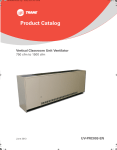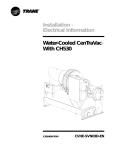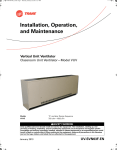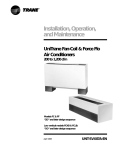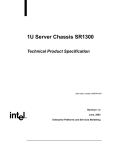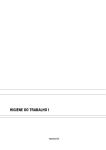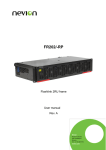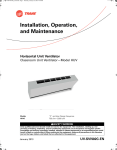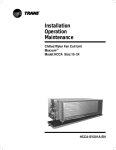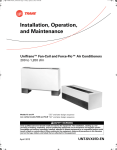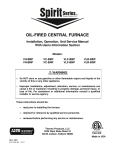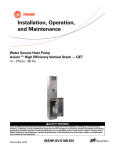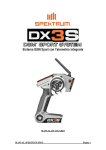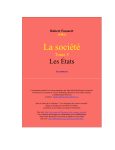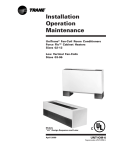Download Trane VUV 1500 CFM User's Manual
Transcript
Installation Owner Maintenance Vertical Unit Ventilator Classroom Unit Ventilator Model VUV Models “A” and later Design Sequence VUVE 750 CFM – 1500 CFM October 2007 UV-SVN03D-EN Notice NOTICE: Warnings and Cautions appear at appropriate sections throughout this manual. Read these carefully. ! WARNING – Indicates a potentially hazardous situation which, if not avoided, could result in death or serious injury. ! CAUTION – Indicates a potentially hazardous situation which, if not avoided, may result in minor or moderate injury. It may also be used to alert against unsafe practices. CAUTION – Indicates a situation that may result in equipment or property-damage-only accidents. Important! Equipment is shipped FOB (Free on Board) at the manufacturer. Therefore, freight claims for damages against the carrier must be initiated by the receiver. © 2007 American Standard All rights reserved. UV-SVN03D-EN Contents Installation/Startup/Commissioning UV-SVN03D-EN 4 Pre-installation Checklist 4 General Information 5 Dimensions/Weights 7 Installation Instructions 14 Electrical Requirements 24 Pre-Startup Checklist 26 Maintenance 27 Warranty Information 30 Troubleshooting Checklist 31 Unit Wiring 33 3 Pre-installation Checklist Jobsite Inspection Always perform the following checks before accepting a unit: 1. Verify that the nameplate data matches the data on the sales order and bill of lading (including electrical data). 2. Verify that the power supply complies with the unit nameplate specifications. 3. Visually inspect the exterior of the unit, for signs of shipping damage. Do not sign the bill of lading accepting the unit(s) until inspection has been completed. Check for damage promptly after the unit(s) are unloaded. Once the bill of lading is signed at the jobsite, the unit(s) are now the property of the SOLD TO party and future freight claims MAY NOT be accepted by the freight company. Microbial Growth! Wet interior unit insulation can become an amplification site for microbial growth (mold), which may cause odors and damage to the equipment and building materials. If there is evidence of microbial growth (mold) on the interior insulation, the insulation should be removed and replaced prior to operating the system. Jobsite Storage This unit is intended for indoor use only. To protect the unit from damage due to the elements, and to prevent possible IAQ contaminant sources from growing. 1. Place the unit(s) on a dry surface or raise above the ground to assure adequate air circulation beneath the unit. 2. Cover the unit(s) with a water proof tarp to protect them from the elements. 3. Make provisions for continuous venting of the covered units to prevent moisture from standing on the unit(s) surfaces. Wet interior unit insulation can become an amplification site for microbial growth (mold) which can be a cause of odors and possible indoor air quality problems. 4. Do not stack units. 4 UV-SVN03D-EN General Information Unit Nameplate The unit nameplate is located in the left hand end pocket, behind the control box. It includes the unit model number, serial number, electrical characteristics, and other pertinent unit data. nance (oiling is not needed), and/or bearing replacement. Factory Shipment Before shipment, each unit is leak tested, and run tested for proper control operation. Sliding Fan Deck Convenient access to the fan motor and wheels for maintenance and serviceability may be made through Trane’s easy-slide fan deck design. Access A three panel front access of the unit ventilator allows for speedy set-up during field commissioning. This design allows for the end pocket of the unit ventilator to be open while the fan (airside) section stays closed. End Pockets Access for piping and controls is made through the unit ventilator’s end pockets. Coil Connections The coil headers and drain connections are made within the unit chassis to allow a tight seal and help prevent air leakage around the coil. The connection sizes vary dependent upon type of coil combination specified. Coil Type Size (in.) Hydronic Cooling (Main) Coil or Heating/Cooling Changeover Coil 3/4" Nominal 7/8" I.D. Heating (Auxiliary) Coil 1/2" Nominal 5/8" I.D. Steam Heating Coil Direct Expansion Coil 1" FNPT 3/8" O.D. Liquid 7/8" O.D. Suction Unit Drain Pan The drain pan is dual-sloped for effective condensate removal. It is made from a non-corrosive material to help eliminate issues associated to leaking or standing water. It may be easily removed for cleaning. The drain pan connection size for all Trane VUVE models is 7/8" O.D. Motor Motors for the VUVE model do not include an external fan bearing on the end of the fan shaft. This helps avoid issues related to fan bearing mainteUV-SVN03D-EN Filters Filter sizing for the unit ventilator are an off-the-shelf design to reduce or help eliminate local stocking of the filters. Outside/Return-Air Dampers The outside-air/return-air damper is a one piece, linkage free design resulting in a superior air-tight seal. Field Installed Controls (Option) The unit comes equipped with a fan speed switch, damper blade (only), and an optional low temperature detection. End Device Control Package (Option) Units containing the End Device control design will incorporate a prewired, selected control components to a terminal strip for wiring a field provided controller and temperature sensor. Note: for controller operation malfunction of any non-Trane, field installed controls, consult the literature or technical support of the controls manufacturer. Tracer™ ZN520 Control Package (Option) The ZN520 electronic digital controller is a factory installed, tested and commissioned LonTalk™ certified design. It may be used in a stand-alone control scheme, or as part of a building automation system. The controller is prewired to Trane selected control components best suited for room comfort. For more information on the ZN520 unit controller operation and service issues, refer to CNT-SVX04A-EN (ZN520 control manual). 5 General Information OA/RA Actuator (Option) The OA/RA actuator provides true spring return operation for positive close-off of the OA/RA damper. The spring return system of the actuator closes the outside damper if power is lost to the building. When ordered with factory controls, the actuator is a 3-point floating design. A 2 to 10 VDC actuator is available when other than Trane controls are specified. See Table 1 for OA/RA technical data. Note: Because the damper actuator is a spring return type an inner spring will close the damper upon loss of power. If the need to service or replace the actuator is required, the spring must be "loaded" for the damper to function properly. The term loaded means that the blade must be held in the return air position upon replacement of the actuator. Face and Bypass Actuator (Option) The face and bypass damper actuator incorporates a direct couple design. It provides electronic protection against overload. A limit switch is not included, nor required as part of the design. When reaching the damper end position, the actuator automatically stops. The gears can be manually disengaged with a button on the housing. See Table 2 for face and bypass actuator specifications. Modulating Water Valves (Option) The modulating control valve provides optimum control of hot and chilled water flow in various heating and cooling applications. They are designed to provide sinusoidal valve actuator travel and operate silently, resisting water hammer. The actuator on the valve is a 24V, 3point floating type. See Table 3 for modulating water valve specifications. Isolation Valve (Option) The isolation valve is a two position 24V, spring return type valve. It provides added control in heating and cooling applications when used in conjunction with the face and bypass damper. 6 Table 1: OA/RA actuator specification Power Supply 24 VAC 24 VAC Power Consumption Transformer Sizing Overload Protection Control Signal Angle of Rotation Torque Direction of Rotation Position Indication Run Time (nominal) Noise Level ± 20% ± 10% 50/60 HZ Power Supply Running: 2.5 W Holding: 1 W 5 VA (class 2-power source) Electronic throughout 0 to 95-degree rotation 2 to 10 VDC 3-point floating with Trane controls Maximum 95-degree Adjustable with mechanical stop 35-inch/lb Spring return reversible with CW/ CCW mounting Visual indicator, 0 to 95-degrees 90-second constant (independent of load) Running: 30 dB Table 3: Mod. water valve specification. Power Supply 24 VAC Power Consumption Max. Duty Cycle Nominal Timing Operating Ambient Temp. Min./Max. Fluid Temp. 4W Operating Pressure Differential Pressure Rating Flow Characteristic Table 2: Face-bypass actuator specification - 50/60 HZ 15% 120 sec. 0 to 65°C 32 to 150°F 1 to 95°C 34 to 203°F Max. - 4 bar (60 psi) 24 VAC 24 VAC Power Consumption Transformer Sizing Angle of Rotation Torque Direction of Rotation Position Indication Run Time (nominal) Manual Override Noise Level Control Signal ± 20% ± 10% 50/60 HZ 2W 3 VA (class 2-power source) Maximum 95-degree Adjustable with mechanical stop 35-inch/lb Reversible with switch L/R Clip-on indicator 90-second constant External push button Less than 35 dB 3-point floating Table 4: Isolation valve specification. Power Supply 24 VAC Power Consumption Max. Fluid Temp. 5W Min. Fluid Temp. Max. Operating Pressure Max. Close-off Pressure - 50/60 HZ 94°C 200°F 1°C 34°F 300 psi 1/2" = 30 psi 3/4" = 20 psi 1" = 15 psi Static - 20 bar (300 psi) Burst - 100 bar (1500 psi) Linear On heating coils, and two-pipe changeover applications, the valve is normally open to help prevent the coil from freezing in-case of power loss. For cooling, the valve is normally closed and opens when there is a call for cooling. See Table 4 for isolation valve specifications. UV-SVN03D-EN Dimensions/Weights/ Clearance ! WARNING Improper Unit Lift! Test lift unit approximately 24 inches to verify proper center of gravity lift point. To avoid dropping of unit, reposition lifting point if unit is not level. Failure to properly lift unit could result in death or serious injury or possible equipment or property-only damage. Table G1: VUVE general data Description Unit Length w/o end covers (inches) Unit Depth - Standard (inches) Unit Depth - with false back (inches) Unit Height - Standard (inches) Shipping Weight (Lbs.) Nominal Filter Size and Quantity (inches) Dynamic Air Filter Nominal Size (inches) & Qty. Drain Connection Size (inches) Fan Type / Quantity Motor Data Quantity Horsepower (ea) Number of Fan Speeds (Standard) If DX or electric heat used Number of Fan Speed (ZN520) If exhaust fan or ERSA used If DX or electric heat used Coil Volume (gal.) Coil Type A B C D E F G H Unit Location and Clearances Locate the unit in an indoor area. The ambient temperature surrounding the unit must not be less than 45°F. Do not locate the unit in areas subject to freezing. Attention should be given to service clearance and technician safety. The unit should contain enough space for UV-SVN03D-EN 0750 69 16 5/8 21 1/4 30 320 14 x 20 x 1 (2) 7 x 42 x 1 (1) Unit Size 1000 1250 81 93 16 5/8 16 5/8 21 1/4 21 1/4 30 30 405 450 14 x 24 x 1 (1) 14 x 20 x 1 (2) 14 x 30 x 1 (1) 14 x 24 x 1 (1) 7 x 54 x 1 (1) 7 x 66 x 1 (1) 1500 105 16 5/8 21 1/4 30 470 14 x 24 x 1 (2) 14 x 30 x 1 (1) 7 x 78 x 1 (1) 7/8 ID Hose FC / 2 7/8 ID Hose FC / 2 7/8 ID Hose FC / 4 7/8 ID Hose FC / 4 1 1/4 3 1 3 2 1 1 1/4 3 1 3 2 1 2 1/10 3 1 3 2 1 2 1/10 3 1 3 2 1 0.178 0.311 0.311 0.444 0.444 0.610 0.610 0.395 0.228 0.410 0.410 0.571 0.571 0.809 0.809 0.593 0.277 0.510 0.510 0.704 0.704 1.014 1.014 0.742 0.327 0.610 0.610 0.931 0.931 1.213 1.213 0.837 service personnel to perform maintenance or repair. Provide sufficient room to make water, and electrical connection(s). Local and national codes should be followed in providing electrical power connections. A 36" clearance at the unit front is sufficient for maintenance and service of the equipment. 7 Dimensions Standard Depth Unit 8 UV-SVN03D-EN Dimensions Falseback Unit UV-SVN03D-EN 9 Dimensions Dynamic Air Barrier Unit 10 UV-SVN03D-EN Dimensions End Covers UV-SVN03D-EN 11 Dimensions Wall Boxes 12 UV-SVN03D-EN Dimensions Crossover Piping 16 5/8" DEPTH UNIT 7/8" I.D. FIELD CONN. W/ SHUT 1 1/2" OFF VALVE FLUSH RETURN 3" SR SUPPLY 3 1/2" 4 1/2" 24" 19 3/8" TOP VIEW 3 5/8" 5 3/8" SIDE VIEW 21 1/4" DEPTH UNIT 7/8" I.D. FIELD CONN. W/ SHUT OFF VALVE FLUSH 1 1/4" RETURN 3" SUPPLY SR 24" 19 3/8" 3 1/2" 4 1/2" TOP VIEW 8 1/4" 10" SIDE VIEW Notes: 1-3/8" o.d. and 2-1/8" o.d. crossover piping 1 Crossover piping is available for all 2 or 4-pipe coils selections. Trane provides the crossover for the cold water only. The crossover pipe is factory insulated with 3/8"-thick insulation. 2 Expansion compensation between the factory piping package and the crossover piping is achieved using a flex hose rated at 250 psi working pressure. flex hose is only available with factory mounted piping packages. 3 Expansion compensation for the crossover piping must be handled external to the unit ventilator. 4 Crossover connections terminate in the same end pocket as the main coil connection. The main coil connection for 2-pipe systems is the heating coil. the main coil connection for 4-pipe systems is the cooling coil. UV-SVN03D-EN 13 Installation Wall Box Installation The following instructions are general recommendations for installing wall intake boxes. Consult the architectural plans for specific requirements. Additional materials required to complete any specific installations (such as duct connections, metal mounting plates, or flanges) are not furnished by Trane. For best results, all air intake boxes should be removable from outside of the building. Weep holes must be at the bottom to permit free drainage. A positive air and moisture seal should be provided around all edges. General Instructions Trane wall boxes are illustrated in the dimensional section of this manual. Dimensions are actual, and may be used to define the wall opening. Vertical louvers in the wall intake box provide extra strength for a high load bearing capacity. The lintel may be omitted on masonry wall installations. Weep holes are provided in the outside face of the bottom channel in the wallbox frame. Install all wall boxes to permit free drainage through the weep holes to the outside of the building. All wallboxes are furnished with diamond pattern expanded aluminum bird screen. Note: V1 and V2 (vertical) wall models are all unflanged. H2, V3 and V6 are flanged. Installation in Masonry Walls A typical method of installing the wall box in a masonry wall opening is shown in Figure 1. Interior Wall w/ sheetrock Outside Wall Grout the top and bottom of the wall box frame as noted. A sloped water dam located in the space between the unit and wall facilitates moisture drainage. Grouting at the ends of the intake box will complete the seal between the wall box frame and the masonry opening. Grout Rubber Seals Weep Holes Installation in Curtain Walls In all cases, the wall intake box should be caulked to provide a tight, weatherproof seal, Figure 2. Note: A minimum of 2-1/8” of clearance must be maintained between the exterior wall and back of the unit. Failure to provide this gap will not allow the wall box to fit properly. Unit Floor Water dam sloped toward exterior Figure 1: Masonry wall installation Interior Wall w/ sheetrock Outside Wall Unit Caulking Rubber Seals Flanged wallbox Weep Holes Water dam sloped toward exterior Figure 2: Flanged wall box installation in 2" curtain wall 14 UV-SVN03D-EN Installation General Installation Checks The checklist below is a summary of the steps required to successfully install a unit. This checklist is intended to acquaint the installing personnel with procedures required in the installation process. It does not replace the detailed instructions called out in the applicable sections of this manual. 1 Carefully remove the stretch wrap and top cardboard cover. Check the unit for shipping damage and material shortage; file a freight claim and notify appropriate sales representation. If end panels have been ordered, the panel will already be mounted to the unit. Location Considerations Selecting the appropriate location for installing a unit is very important. The following factors should be considered: 5 Internal access to the unit is provided by the removable front panel. Sufficient space should be allowed to lift the panel for maintenance purposes. 1 6 Ensure the floor surface is level. Note: The unit leveling legs can be adjusted to accommodate slight out-of-level installation surfaces. 2 Note: The unit ventilator is packaged in clear stretch wrap to allow for immediate visual inspection. A protective cardboard cover helps prevent scratching and other cosmetic blemishes during transport. 2 Remove remaining cardboard blocking. 3 Remove the unit’s left front panel to verify nameplate/sales order number is correct. It is located behind the control box. 4 Remove shipping bracket from the lower rear corners of the unit to separate the unit from the skid. Access to the screws holding the bracket to the skid is obtained inside the unit. 5 Rotate the fan wheels manually. The wheels should move freely and be in proper alignment. Visually inspect the fan area for obstructions or shipping damage. 6 Remove all applicable knockouts for coil piping and electrical connections. UV-SVN03D-EN Floor design must have sufficient structure to withstand the weight of the unit while allowing for openings in the floor for a return air duct, electrical and piping supply lines fed through the floor. See page 7 for unit weights. Wall space design should allow the unit to be mounted to the wall securely. The wall surface behind the unit should be smooth and level. Wall and floor moldings should be removed prior to installation. A wall slightly out of level may cause problems with unconditioned air leaking into the room. Remove any object projecting more then 1/8” (.3175cm) from the wall surface. Note: Additional gasket or furr strips may be installed to accommodate for an uneven wall. 3 There are two removable knockouts in the rear of the unit, on either end, for piping and electrical supply lines. A pipe chase is located in the upper back portion of the unit for crossover piping. The outside air opening is located in the lower back of the unit and the path to the wallbox on the outside wall should be unobstructed. 4 The physical layout of the room should accommodate any accessories ordered with the unit. Conditioned air is distributed through the grille on top of the unit and returned through the return air grille on the bottom of the unit. Avoid placing any objects that may obstruct either grille or interfere with airflow. Unit Mounting Note: All wall intake boxes should be installed prior to mounting the unit ventilator. Refer to Page 14 for wall box installation instructions. The 1/2” mounting or anchoring holes are located on the back of the unit on each end. See Figures 3. Note: All mounting fasteners are to be provided by the installer. 15 Installation Figure 3: Mounting hole location F E C C B B A 075 100 125 150 16 Standard Unit (no Falseback) Standard falseback 29" stepdown falseback 28" stepdown falseback 27" stepdown falseback 26" stepdown falseback 25" stepdown falseback Standard Unit (no Falseback) Standard falseback 29" stepdown falseback 28" stepdown falseback 27" stepdown falseback 26" stepdown falseback 25" stepdown falseback Standard Unit (no Falseback) Standard falseback 29" stepdown falseback 28" stepdown falseback 27" stepdown falseback 26" stepdown falseback 25" stepdown falseback Standard Unit (no Falseback) Standard falseback 29" stepdown falseback 28" stepdown falseback 27" stepdown falseback 26" stepdown falseback 25" stepdown falseback D A 1.31 1.00 1.00 1.00 1.00 1.00 1.00 1.31 1.00 1.00 1.00 1.00 1.00 1.00 1.31 1.00 1.00 1.00 1.00 1.00 1.00 1.31 1.00 1.00 1.00 1.00 1.00 1.00 B 13.50 2.13 2.13 2.13 2.13 2.13 2.13 13.50 2.13 2.13 2.13 2.13 2.13 2.13 13.50 2.13 2.13 2.13 2.13 2.13 2.13 13.50 2.13 2.13 2.13 2.13 2.13 2.13 C 2.75 26.00 24.44 23.44 22.44 21.44 20.44 2.75 26.00 24.44 23.44 22.44 21.44 20.44 2.75 26.00 24.44 23.44 22.44 21.44 20.44 2.75 26.00 24.44 23.44 22.44 21.44 20.44 D 66.39 67.00 67.00 67.00 67.00 67.00 67.00 78.39 79.00 79.00 79.00 79.00 79.00 79.00 90.39 91.00 91.00 91.00 91.00 91.00 91.00 102.39 103.00 103.00 103.00 103.00 103.00 103.00 E 10.38 10.00 10.00 10.00 10.00 10.00 10.00 10.38 10.00 10.00 10.00 10.00 10.00 10.00 10.38 10.00 10.00 10.00 10.00 10.00 10.00 10.38 10.00 10.00 10.00 10.00 10.00 10.00 F 45.64 47.00 47.00 47.00 47.00 47.00 47.00 57.64 59.00 59.00 59.00 59.00 59.00 59.00 69.64 71.00 71.00 71.00 71.00 71.00 71.00 81.64 83.00 83.00 83.00 83.00 83.00 83.00 UV-SVN03D-EN Installation Unit Mounting Note: All wall intake boxes should be installed prior to mounting the unit ventilator. Refer to Page 14 for wall box installation instructions. The 1/2” mounting or anchoring holes are located on the back of the unit on each end. See Figure 3. 1 2 Note: All mounting fasteners are to be provided by the installer. Check the gasket on the rear of the unit and around the fresh air opening. Gaps around the openings can lead to outside air leaks into the room. Remove all electrical and piping knockouts where required for installation. rather than the holes located in the unit’s end pockets. Note: Ensure the unit is level. Coils and drain pans inside the unit are pitched properly for draining before shipment. 5 Ensure the unit rests tightly against the wall. Check for proper seal and that air does not leak underneath the unit. Subbase (option) A subbase may be used to increase the unit height and aid in leveling the unit. The subbase is shipped separately for field installation. Slots and leveling screws are provided on the subbase. 1 ! WARNING Remove the leveling legs provided with the unit. See Figure 4. Improper Unit Lift! Test lift unit approximately 24 inches to verify proper center of gravity lift point. To avoid dropping of unit, reposition lifting point if unit is not level. Failure to properly lift unit could result in death or serious injury or possible equipment or property-only damage. 3 Set the unit into selected location and adjust leveling legs if necessary to ensure level fit. Push the unit tightly against the wall to compress the seal on the back edge of the unit and intake opening. Anchor the unit by using the 1/2” mounting holes in both end pockets. Units containing a falseback; The falseback unit ventilator contains mounting holes located on the falseback metal. Use these holes UV-SVN03D-EN It is recommended end panels be installed on the unit ventilator after all piping, wiring and accessory installation is completed. To install the end panel: 1 Insert the four factory provided metal studs into the four premounted nuts on the inside of the panel. 2 Align each stud with the four predrilled holes on the side of the unit. 3 Secure the panel to the unit by fastening with the four factory provided nuts. 4 Do not overtighten screws. Unit Base Weld Nuts 2"- 6" Subbase For leveling legs Figure 4: Subbase with leveling legs 2 Note: Care should be taken when handling the unit to ensure that the front return air grille does not bend. 4 End Panels When ordered as an option, end covers ship already attached to the vertical unit ventilator. The following section is for installing end covers purchased as an add-on. Set the unit on the subbase and fasten with four, 3/8” x 16’ x 1” hex head cap screws and 3/8" lock washers. CAUTION Equipment Damage! Do not run units for any length of time without all panels and filters properly installed. Failure to do so may result in equipment failure. Note: Hex screws and lock washers are provided by the factory. They are located in a baggy and are used to attach the base to the unit ventilator. Pre-drilled slots in the subbase flange will line up with the weld nuts in the bottom of the unit. 3 The bottom of the subbase has weld nuts in four slots. Place the leveling legs in those slots and level the unit. 17 Installation Piping Installation Before installation of piping package, the shipping bracket holding the piping in place, must be removed. Proper installation of piping is necessary to provide efficient coil operation and to prevent damage during operation. Follow standard piping practices and include all accessories as necessary. Piping connection knockouts are shown pages 8 to 10. Field connection types and sizes for unit coils are listed in Table 5. These sizes are provided for field piping connection. A 7/8’’ OD condensate drain connection is provided on the chilled water supply end of the unit. 1 Attach a flexible condensate drain hose over the drain pan connection and secure with a hose clamp. The drain pan on the vertical is vacuum molded with a drain connection and P-Trap on the cooling coil, connection side. Note: Condensate removal to the main system should be made through the bottom of the unit ventilator. If other location for condensate removal is desired, a specific field cut-out for the connection should be made in the back of the unit ventilator. To help avoid cold air infiltration, the field cut-out should only be large enough to allow for the condensate hose to exit the unit. To field reverse the slope of a vertical unit drain pan. 2 Slide out fan deck (disconnecting the condensate line and fan plug will release fan deck for sliding). 7 After the condensate drain piping has been completed, check water flow to ensure the system properly carries and away all condensate accumulation. Note: A P-trap is factory supplied in every vertical unit ventilator. Trane Piping Packages (Option) Trane Standard Piping Package includes a 2-way or 3-way valve with bypass balance valve, ball valves, Pete’s plugs and unions. A strainer and circuit balancing valve are optional. 1 All union connections should be tightened in the field. Units are shipped with union connections hand tightened only in the factory. Note: All connections made in the field should be sweat connections. Piping packages are not shipped insulated. Any insulation should be provided in the field by the installing contractor. The auxiliary drain pan (optional) is the main condensate connection to the unit when specified. The chilled water or DX coil drain pan will empty into the auxiliary drain pan if a factory installed, auxiliary pan is ordered. All field piping condensate connections should be made at the auxiliary drain pan. Installation Crossover Piping Crossover piping is available for all hydronic coils. It is either 1 3/8’’ \[34.9\] or 2 1/8’’ \[54\] in diameter (O.D.) as specified by the customer. Crossover piping can be found in either the left or right hand end pocket. See crossover submittal drawings page 13 for dimensional data. On 4-pipe coils, crossover piping connects to the main cooling coil. Factory insulation is provided on all crossover piping. When a Trane piping package is ordered, it is installed with the connections made to the supply and return of both the coil and the crossover piping. However, supply and return connections must be made in the field when a piping package is furnished by the installer. The crossover piping is located at the back of the unit along the wall and the ends of the piping are flush with the end of the unit. Expansion compensation between the piping package and the crossover piping is achieved using flex hoses rated at 250 psi working pressure. Expansion compensation for the crossover piping must be handled external to the unit ventilator. Table 7: Coil data for field piping Coil Type Connection Location Field Connection Size Left or Right (opposite ends) 7/8" OD/5/8" OD 2-Pipe Changeover Coil Left or Right 7/8" OD Hot Water Only Left or Right 7/8" OD Steam Left or Right 1" MPT Chilled Water/Electric Heat Left Cooling 7/8" OD Chilled Water/Steam Left or Right 7/8" OD/1" MPT Left 7/8" Suction, 3/8" Discharge 4-Pipe Chilled Water/Hot Water 3 Remove pipe clamp that hold the p-trap to the drain pan. DX DX/Hot Water Left Cooling/Right Heating 7/8" Suction, 3/8" Discharge/5/8" OD 4 Remove clips that hold the drain pan in-place. DX/Steam Left Cooling/Right Heating 7/8" Suction, 3/8" Discharge/1" MPT DX/Electric Heat Left Cooling/Right Heating 7/8" Suction, 3/8" Discharge/NA 5 Lift and rotate the drain pan. Electric Heat Right NA 6 Reconnect p-trap to the drain pan and replace clips to secure the pan to the fan deck. 18 Notes: 1. Supply and return connections are located on the same end of each coil. 2. All Trane piping packages have union connections; all units with piping packages by others have sweat connections. 3. Coil connections are sweat except steam coils, which are threaded. UV-SVN03D-EN Installation Split System Units The following refrigerant piping and interconnecting wiring instructions apply to unit ventilators with direct expansion type cooling coils used in conjunction with air-cooled condensing units. Reference must also be made to the condensing unit installation and wiring manuals which are shipped with the condensing unit. Note: The ETL listing mark applied to a unit ventilator does not apply to any associated refrigerant condensing unit. Refrigerant Piping Unit ventilators with direct expansion cooling contain a nitrogen holding charge in the evaporator coils. Connections are ‘‘pinched-off’’ at the factory. To connect the condensing unit lines, cut off the stubouts and swage. The condensing unit lines can then be brought into the swage and brazed. Trane recommends the use of nitrogen purge when brazing refrigerant lines to prevent formation of oxides in the lines. Install the refrigerant suction and liquid lines as described in the condensing unit installation instructions. The TXV is factory installed on the Unit Ventilator. Piping should be run straight out through the back of the unit. Access piping knockouts are located in the rear panels of the unit, as shown in dimensional section of this manual. Steam Piping When air, water or another product is heated, the temperature or heat transfer rate can be regulated by a modulating steam pressure control valve. Since pressure and temperature do not vary at the same rate as load, the steam trap capacity, which is determined by the pressure differential between the trap inlet and outlet, may be adequate at full load, but not some lesser load. There are detailed methods for determining condensate load under various operating conditions. However, in most cases this is not necessary if the coils are piped as shown in Figure 5. Follow the procedure documented in the ASHRAE Systems Handbook, Steam Systems. Temp. Regulating Valve Coil To Condensate return H= 12" minimum Vacuum Equalizer F&T Trap See text for sizing Gravity flow to vented receiver Figure 5: Steam piping Recommended refrigerant line connections for various unit combinations are given in Table 7. Typical Superheat Charging Charts are shown in the Trane Service Facts found in the condensing unit section manual. Refrigerant charge weights can also be determined with your local Trane sales engineer using a valid Trane Selection Program. UV-SVN03D-EN 19 Installation Modulating Water Valves (Option) The actuator on the valve is a 24V, 3point floating valve. The actuator can be easily removed from the valve body by pressing in on the locking tab and rotating the actuator 45° counterclockwise (See Figure 6a). The 2-way valves are bi-directional flow. The 3way valves can be mixing or diverting (See Figure 6b). Note: The actuator must be removed if soldering is being conducted near the valve. High heat may cause damage to the actuator’s plastic body/mechanisms. Figure 6b: Steam piping Use the following steps to complete cartridge assembly removal: Closed 1 Remove valve actuator. B A 3 Solder the valve in accordance with normal soldering practices. Open B A 2-way valve AB<->B AB AB<->A A 3-way valve On applications without the optional, factory installed piping packages, it is important to remove the cartridge assembly from the valve body with the provided tool (Figure 7). Figure 6a: Remove modulating valve actuator by pressing in tab (inset) and turning actuator 45° counterclockwise. 4 Re-install the cartridge after soldering by tightening until it bottoms out. The top surface of the cartridge will be flush with the top edge of the body casting. Note: Do not overtighten. Maximum torque is 40 in-lb. 5 Replace valve actuator and wire in accordance with instructions. B AB 2 Remove the cartridge assembly from the valve body with the enclosed tool. Figure 7: Cartridge removal tool Plumbing the Valve The valve may be plumbed in any angle but preferably not with the actuator below horizontal level of the body. Make sure there is enough room around the actuator for servicing or replacement. For use in diverting applications, the valve is installed with the flow water entering through the bottom AB port and diverting through end ports A or B. In mixing applications the valve is installed with inlet to A or B and outlet through AB. Mount directly to the tube or pipe. Do not grip the actuator while making or tightening plumbing connections. Either hold valve body by hand or attach an adjustable spanner (38mm/1-1/2”) across the hexagonal or flat faces on the valve body. See Figure 8. Figure 8: Proper plumbing technique for modulating valves 20 UV-SVN03D-EN Installation Manually Opening Valve The manual opener can be manipulated only when in the up position. The A port can be manually opened by firmly pushing the white manual lever down to the midway position and pushing the lever in. In this position, both A and B ports are open. This “manual open” position may be used for filling, venting and draining the system or opening the valve during power failure. the normally open (NO) or normally closed (NC) contacts, driving the valve to an intermediate position until a further change at the controller. The valve can be closed by depressing the white lever lightly and then pulling the lever outward. The valve and actuator will return to the automatic position when power is restored. Isolation Valves Installation The valve can be mounted in any position on a vertical line. If the valve is mounted horizontally, the actuator must be even with or above the center line. Make sure there is enough room to remove actuator cover for servicing. Mount the valve on the tube or pipe. Note: If the valve is powered open, it cannot be manually closed, unless the actuator is removed. Wiring A controller and a separate transformer is required to operate each valve. See Figures 9 and 10. Port A “open” and “closed” denote valve open and closed positions. Figure 12: Removing valve actuator The valve is set between the limits of the controller to satisfy various load requirements. In the event of power failure, the valve will stay in the position it was in before loss of power. When power is restored, the valve will again respond to controller demand. To install the actuator to the valve body: 3 Note: Ensure the flow through the valve is in the direction indicated by the arrow stamped on the valve body. Align the slot on the shaft of the valve with the valve body notch on side of body. See Figure 13. Figure 9: Wiring for modulating valve actuator Figure 11: Proper mounting for isolation valves. Figure 10: Wiring for modulating valve actuator The typical floating controller is an SPDT controller with a center-off position. On a change in temperature from the set point, the controller will close UV-SVN03D-EN Servicing/Removal of Valves The actuator can be removed from the valve body. Removing the actuator is recommended if soldering is being conducted near the valve. To remove the actuator: 1 Place the manual operating lever to the Open position, Figure 12 2 Depress the locking button and lift actuator until it separates from the valve body. Figure 13: Installing isolation valve 4 Install body valve into pipe. 5 Wiring connections may be made either before or after actuator installed on body. 6 Place the manual operating lever on the actuator in the OPEN position. 7 Align actuator coupling to slot on the shaft of the valve body and fit the head onto the valve body to ensure the shaft seats correctly, Figure 11. 8 Press the actuator and valve body until it secures together. 21 Installation Soldering procedures are as follows: 1 Remove actuator as stated earlier. Wiring All classroom unit ventilators have 115V motor power. Motor data can be found in Tables G1. 2 Control Power 3 Place valves on the pipe. Rotate valve stem so the shaft slot points at the notch in the side of the body (90° to flow direction). This protects the plug inside the valve by removing it from the seat, Figure 14. Sweat the joints, keeping outer surface free from solder. Note: Do not use silver solder due to high temperature requirements. ! WARNING Hazardous Voltage! Disconnect all electric power, including remote disconnects before servicing. Follow proper lockout/tagout procedures to ensure the power can not be inadvertently energized. Failure to disconnect power before servicing could result in death or serious injury. CAUTION Equipment Damage! Figure 14: Preparation for soldering Heating Coils with Direct Expansion Cooling Heating options for direct expansion cooling in the unit ventilator are hot water, steam or electric heat. These coils facilitate direct expansion cooling with standard capacities. The supply and return connections are located in the right hand end pocket. Hot water field connections are made with a 5/8’’ \[15.9\] OD male sweated joint, while steam coils have a 1’’ \[25.4\] male pipe thread (MPT) connection. See Table 7 for coil connection sizes. Electric heat coils provide a third way to supply heating to the direct expansion cooling. The coil utilizes three to six preheat elements which are factory wired. 22 -Wiring diagrams provided in this manual are for reference only. Actual wiring for particular options/ units may vary. Refer to the diagram provided on the equipment for specific information. Failure to do so may result in equipment failure. -When installing field provided controls, do not alter or remove any built-in unit safeties. Tampering with unit safeties may cause unit overheating and possible fire hazard. -Do not remove or alter the wiring of the Time Delay Relay (DL). Doing so may result in premature motor failures. Unit ventilator controls and control wiring can be factory mounted or field installed. Wiring diagrams illustrate the standard unit motors with one and two speed control. Terminal wiring is provided by Trane and the actual components used for a particular installation may differ. Control and line diagrams for the exact control system used are provided with each unit. Supply Power CAUTION Use Copper Conductors Only! Unit terminals are not designed to accept other types of conductors. Failure to use copper conductors may result in equipment damage. Power supply wiring is to be connected to terminals 1 and 2 at the junction box in the left end pocket, below the discharge air grille. Electric Heat (option) Supply Power Supply power wiring is to be connected to the following line terminals in the right hand end pocket: • 208V or 240V, 3-phase, 3 wire system: L1, L2 and L3. • 480V, 3-phase, 4 wire system: L1, L2, L3 and N (neutral) See Page 34 for a typical unit line and interconnecting wiring diagram for Electric Heat Coils. CAUTION Equipment Damage! 480 V/3-Wire is NOT compatible with Trane Classroom Unit Ventilator equipment. There must be a 4-wire system with a separate ground. Failure to provide a 4-wire system may result in equipment damage. Note: The supply neutral wire must be connected to the neutral terminal block. Operational controls and an electric heating safety device are factory mounted. The safety device is a high temp cut-out which de-energizes electric heating elements through the K1 safety contactor. UV-SVN03D-EN Installation ! WARNING Hazardous Voltage! Disconnect all electric power, including remote disconnects before servicing. Follow proper lockout/tagout procedures to ensure the power can not be inadvertently energized. Failure to disconnect power before servicing could result in death or serious injury. IMPORTANT: INSTALLER MUST MOUNT THERMAL EXPANSION VALVE BULB AND FROST PROTECTION BULB (if suppled) TO SUCTION LINE AFTER CONNECTION OF FIELD REFRIGERANT PIPING X39001939010A Wiring (continued) DX System A typical unit ventilator with DX coil includes an outside air thermostat, a frost prevention thermostat and a 24V transformer for condensing unit control. Wire sizing is the same as given for the thermostat wiring in the condensing unit installation instructions, or may be obtained from the nameplate. The condensing unit must be controlled by the same room thermostat that also controls the unit ventilator. X 12 9:00 9 3 6 8:00 3:00 4:00 X MOUNT BULB IN HORIZONTAL PLANE RECOMMENDED BULB PLACEMENT Figure 15: Frost stat/TXV valve installation tag Note: Depending on the controls package ordered with the unit, not all installations will require mounting the frost stat bulb. Split System Start-Up After all piping and wiring has been completed, follow the instructions provided with the condensing unit for control testing and system start-up. If sweat type field-piped systems are being used, then pressure testing, evacuation and refrigerant charging will be required. Two bulbs will also be shipped with a split system unit: • Frost stat bulb • TXV valve (used with R410a). Both components are to be field installed using the installation kit shipped with the unit. For complete installation instructions and locations, refer to the tag attached to the installation kit within the unit. See Figure 15 for an example of the installation tag. UV-SVN03D-EN 23 Electrical Requirements Table E1: VUV 075-150, Electrical Performance Model No. VUVE075 VUVE100 24 Unit Voltage 115/60/1 208/60/1 208/60/1 208/60/1 208/60/1 208/60/3 208/60/3 208/60/3 208/60/3 230/60/1 230/60/1 230/60/1 230/60/1 230/60/3 230/60/3 230/60/3 230/60/3 265/60/1 265/60/1 265/60/1 265/60/1 460/60/3 460/60/3 460/60/3 460/60/3 115/60/1 208/60/1 208/60/1 208/60/1 208/60/1 208/60/3 208/60/3 208/60/3 208/60/3 230/60/1 230/60/1 230/60/1 230/60/1 230/60/3 230/60/3 230/60/3 230/60/3 265/60/1 265/60/1 265/60/1 265/60/1 460/60/3 460/60/3 460/60/3 460/60/3 Blower Motor FLA (ea) 3.0 1.6 1.6 1.6 1.6 1.6 1.6 1.6 1.6 1.6 1.6 1.6 1.6 1.6 1.6 1.6 1.6 1.0 1.0 1.0 1.0 1.0 1.0 1.0 1.0 3.0 1.6 1.6 1.6 1.6 1.6 1.6 1.6 1.6 1.6 1.6 1.6 1.6 1.6 1.6 1.6 1.6 1.0 1.0 1.0 1.0 1.0 1.0 1.0 1.0 Blower Motor HP 1/4 1/4 1/4 1/4 1/4 1/4 1/4 1/4 1/4 1/4 1/4 1/4 1/4 1/4 1/4 1/4 1/4 1/4 1/4 1/4 1/4 1/4 1/4 1/4 1/4 1/4 1/4 1/4 1/4 1/4 1/4 1/4 1/4 1/4 1/4 1/4 1/4 1/4 1/4 1/4 1/4 1/4 1/4 1/4 1/4 1/4 1/4 1/4 1/4 1/4 No. of Fan Motor 1 1 1 1 1 1 1 1 1 1 1 1 1 1 1 1 1 1 1 1 1 1 1 1 1 1 1 1 1 1 1 1 1 1 1 1 1 1 1 1 1 1 1 1 1 1 1 1 1 1 Number of Heating Elements 0 0 3 4 6 0 3 4 6 0 3 4 6 0 3 4 6 0 3 4 6 0 3 4 6 0 0 3 4 6 0 3 4 6 0 3 4 6 0 3 4 6 0 3 4 6 0 3 4 6 Electric Heat kW 0.00 0.00 4.39 5.86 8.79 0.00 4.39 5.86 8.79 0.00 5.85 7.80 11.70 0.00 5.85 7.80 11.70 0.00 5.82 7.80 11.70 0.00 5.85 7.80 11.70 0.00 0.00 5.86 7.81 11.72 0.00 5.86 7.81 11.72 0.00 7.80 10.40 15.60 0.00 7.80 10.40 15.60 0.00 7.80 10.40 15.60 0.00 7.80 10.40 15.60 Electric Heat Amps 0.00 0.00 21.10 28.20 42.30 0.00 12.20 18.69 24.40 0.00 24.40 32.50 48.80 0.00 14.10 21.49 28.10 0.00 21.00 28.20 42.20 0.00 7.00 14.10 14.10 0.00 0.00 28.20 37.50 56.30 0.00 16.30 24.79 32.50 0.00 32.50 43.30 65.00 0.00 18.80 28.66 37.50 0.00 28.20 37.50 56.30 0.00 9.40 18.80 18.80 Total FLA 3.00 1.60 22.70 29.80 43.90 1.60 13.80 20.29 26.00 1.60 26.00 34.10 50.40 1.60 15.70 23.09 29.70 1.00 22.00 29.20 43.20 1.00 8.00 15.10 15.10 3.00 1.60 29.80 39.10 57.90 1.60 17.90 26.39 34.10 1.60 34.10 44.90 66.60 1.60 20.40 30.26 39.10 1.00 29.20 38.50 57.30 1.00 10.40 19.80 19.80 Minimum Circuit Ampacity 3.8 2.0 28.4 37.3 54.9 2.0 17.3 25.4 32.5 2.0 32.5 42.6 63.0 2.0 19.6 28.9 37.1 1.3 27.5 36.5 54.0 1.3 10.0 18.9 18.9 3.8 2.0 37.3 48.9 72.4 2.0 22.4 33.0 42.6 2.0 42.6 56.1 83.3 2.0 25.5 37.8 48.9 1.3 36.5 48.1 71.6 1.3 13.0 24.80 24.8 Overcurrent Protective Device 15 15 30 40 60 15 20 30 35 15 35 45 70 15 20 30 40 15 30 40 60 15 15 20 20 15 15 40 50 80 15 25 35 45 15 45 60 90 15 30 40 50 15 40 50 80 15 15 25 25 UV-SVN03D-EN Electrical Requirements Table E1: VUV 075-150, Electrical Performance (continued) Model No. VUVE125 VUVE150 UV-SVN03D-EN Unit Voltage 115/60/1 208/60/1 208/60/1 208/60/1 208/60/1 208/60/3 208/60/3 208/60/3 208/60/3 230/60/1 230/60/1 230/60/1 230/60/1 230/60/3 230/60/3 230/60/3 230/60/3 265/60/1 265/60/1 265/60/1 265/60/1 460/60/3 460/60/3 460/60/3 460/60/3 115/60/1 208/60/1 208/60/1 208/60/1 208/60/1 208/60/3 208/60/3 208/60/3 208/60/3 230/60/1 230/60/1 230/60/1 230/60/1 230/60/3 230/60/3 230/60/3 230/60/3 265/60/1 265/60/1 265/60/1 265/60/1 460/60/3 460/60/3 460/60/3 460/60/3 Blower Motor FLA (ea) 2.0 1.0 1.0 1.0 1.0 1.0 1.0 1.0 1.0 1.0 1.0 1.0 1.0 1.0 1.0 1.0 1.0 0.9 0.9 0.9 0.9 0.9 0.9 0.9 0.9 2.0 1.0 1.0 1.0 1.0 1.0 1.0 1.0 1.0 1.0 1.0 1.0 1.0 1.0 1.0 1.0 1.0 0.9 0.9 0.9 0.9 0.9 0.9 0.9 0.9 Blower Motor HP 1/10 1/10 1/10 1/10 1/10 1/10 1/10 1/10 1/10 1/10 1/10 1/10 1/10 1/10 1/10 1/10 1/10 1/10 1/10 1/10 1/10 1/10 1/10 1/10 1/10 1/10 1/10 1/10 1/10 1/10 1/10 1/10 1/10 1/10 1/10 1/10 1/10 1/10 1/10 1/10 1/10 1/10 1/10 1/10 1/10 1/10 1/10 1/10 1/10 1/10 No. of Fan Motor 2 2 2 2 2 2 2 2 2 2 2 2 2 2 2 2 2 2 2 2 2 2 2 2 2 2 2 2 2 2 2 2 2 2 2 2 2 2 2 2 2 2 2 2 2 2 2 2 2 2 Number of Heating Elements 0 0 3 4 6 0 3 4 6 0 3 4 6 0 3 4 6 0 3 4 6 0 3 4 6 0 0 3 4 6 0 3 4 6 0 3 4 6 0 3 4 6 0 3 4 6 0 3 4 6 Electric Heat kW 0.00 0.00 7.32 9.76 14.65 0.00 7.32 9.76 14.65 0.00 9.75 13.00 19.50 0.00 9.75 13.00 19.50 0.00 9.75 13.00 19.50 0.00 9.75 13.00 19.50 0.00 0.00 8.56 11.42 17.13 0.00 8.56 11.42 17.13 0.00 11.40 15.20 22.80 0.00 11.40 15.20 22.80 0.00 11.40 15.20 22.80 0.00 11.40 15.20 22.80 Electric Heat Amps 0.00 0.00 35.20 46.90 70.40 0.00 20.30 31.03 40.70 0.00 40.60 54.20 81.30 0.00 23.50 35.82 46.90 0.00 35.20 46.90 70.40 0.00 11.70 23.50 23.50 0.00 0.00 41.20 54.90 82.40 0.00 23.80 36.36 47.50 0.00 47.50 63.30 95.00 0.00 27.40 41.87 54.80 0.00 41.20 54.90 82.30 0.00 13.70 27.40 27.40 Total FLA 4.00 2.00 37.20 48.90 72.40 2.00 22.30 33.03 42.70 2.00 42.60 56.20 83.30 2.00 25.50 37.82 48.90 1.80 37.00 48.70 72.20 1.80 13.50 25.30 25.30 4.00 2.00 43.20 56.90 84.40 2.00 25.80 38.36 49.50 2.00 49.50 65.30 97.00 2.00 29.40 43.87 56.80 1.80 43.00 56.70 84.10 1.80 15.50 29.20 29.20 Minimum Circuit Ampacity 4.5 2.3 46.3 60.9 90.3 2.3 27.6 41.0 53.1 2.3 53.0 70.0 103.9 2.3 31.9 47.0 60.9 2.0 46.0 60.7 90.0 2.0 16.6 31.40 31.4 4.5 2.3 53.8 70.9 105.3 2.3 32.0 47.7 61.6 2.3 61.9 81.4 121.0 2.3 36.5 54.6 70.8 2.0 53.5 70.7 104.9 2.0 19.1 36.30 36.3 Overcurrent Protective Device 15 15 50 70 100 15 30 45 60 15 60 80 110 15 35 50 70 15 50 70 100 15 20 35 35 15 15 60 80 110 15 35 50 70 15 70 90 125 15 40 60 80 15 60 80 110 15 20 40 40 25 Pre-Start Checklist Pre-Start-up Checklist Before energizing the unit, the following system devices must be checked: ____ Is the high voltage power supply correct and in accordance with the nameplate ratings? ____ Is the field wiring and circuit protection the correct size? ____ Is the low voltage control circuit wiring correct per the unit wiring diagram? ____ Is the piping system clean/complete and correct? ____ Is unit serviceable? (See clearance specifications on page 7). ____ Are all the unit access panels secure and in place? ____ Is the water flow established and circulating through all the units? ____ Is the condensate line properly sized, run, trapped and pitched? ____ Does the indoor blower turn freely without rubbing? ____ Has all work been done in accordance with applicable local and national codes? ____ Has heat transfer fluid been added in the proper mix to prevent freezing if required? 26 UV-SVN03D-EN Maintenance ! WARNING Hazardous Service Procedures! The maintenance and troubleshooting procedures recommended in this section of the manual could result in exposure to electrical, mechanical or other potential safety hazards. Always refer to the safety warnings provided throughout this manual concerning these procedures. When possible, disconnect all electrical power including remote disconnects before servicing. Follow proper lockout/tagout procedures to ensure the power can not be inadvertently energized. When necessary to work with live electrical components, have a qualified licensed electrician or other individual who has been trained in handling live electrical components perform these tasks. Failure to follow all of the recommended safety warnings provided, could result in death or serious injury. Service Access To access the unit for water balancing, motor access or other start-up and maintenance functions, use one of the following methods: 1 Remove the end pocket front panel. 2 Remove the return air grille by releasing the mounting screws. 3 If there is no shelving or other obstructions, removing the end panel may allow more access. Periodic Maintenance The following maintenance suggestions apply to all types of unit ventilators, chilled water, hot water, split systems and electric. Additional information for controls not supplied by The Trane Company should be obtained from the controls manufacturer. Split system unit ventilators include a condensing unit and the instructions provided with the condensing unit will apply to the entire refrigerant system. Filters The air filters supplied with Trane UV’s are specially designed for high lint content. Depending upon room conditions, these filters will normally need to be replaced every 4 to 8 weeks. To assure proper unit operation, inspect the filters monthly and clean or replace as required. Cleaning of the Drain Pan The unit ventilators drain pan is removable for periodic cleaning or easy access for maintenance/drainage issues. Use Figure 16, and the steps below for removing the drain pan. 1 Turn off power to the unit and remove the front panel. 2 Disconnect the condensate drain line from the P-trap. 3 Disconnect fan plug. 4 Remove (4) pan clips located at each end of the pan’s front. 5 Slide out fan board. 6 Remove drain pan for cleaning. 7 When reinstalling, reverse sequence. Overloaded filters will reduce unit air handling capacity, which may result in insufficient heating during the morning warm-up period and loss of natural cooling capacity during mild weather. Filter Replacement The air filter on the vertical unit is located near the bottom of the unit Filter sizing may be found on Table G1. . 1 To remove the filters, take-off the air section’s front panel. 2 Slide the filter out of the filter rack on the bottom of the unit. 3 Replace old filter with new filter and re-attach front panel. Slide out fanboard 1 3 4 2 Figure 16: Removal of drainpan CAUTION Equipment Damage! Do not operate unit without filters or grilles in place. Failure to do so may cause equipment failure UV-SVN03D-EN 27 Maintenance ! WARNING Hazardous Service Procedures! The maintenance and troubleshooting procedures recommended in this section of the manual could result in exposure to electrical, mechanical or other potential safety hazards. Always refer to the safety warnings provided throughout this manual concerning these procedures. When possible, disconnect all electrical power including remote disconnects before servicing. Follow proper lockout/tagout procedures to ensure the power can not be inadvertently energized. When necessary to work with live electrical components, have a qualified licensed electrician or other individual who has been trained in handling live electrical components perform these tasks. Failure to follow all of the recommended safety warnings provided, could result in death or serious injury. Access to Fanboard & Motor The unit ventilator fan board can be removed for service to the blower motor and fan wheels. The fan board must also be removed for easier access to the unit coils for cleaning and maintenance. Utilize the following steps for proper removal of the fanboard. 1 Turn off power to the unit and remove the front panel. 2 Disconnect P-trap from drain pan. 3 Disconnect fan plug. 4 Slide fan board by pulling deck forward, Figure 17. CAUTION Equipment Damage! Attach new motor to fan shaft and reverse steps to complete installation. Support the fanboard to prevent the deck from sliding too far forward and falling out of the unit. Failure to do so may cause equipment damage. 5 When reinstalling, use the same steps in reverse order. Motor The fan motor is a permanent split capacitor type motor with voltage specific power. See Table E1 through E3 for electrical performance and motor voltage. Table E3: Motor Voltage Unit Voltage Motor Voltage 115-60-1 115-60-1 208-60-1 208/230-60-1 230-60-1 208/230-60-1 208-60-3 208/230-60-1 460-60-3 265-60-1 265-60-1 265-60-1 230-60-3 208/230-60-1 If a replacement motor is required, it should be ordered from The Trane Company. To replace the fan motor, complete the following steps: 6 Complete steps for removal of fan board. 7 Disconnect the motor ground wire. 8 Using a 7/16” Allen wrench, loosen the coupling on the fan shaft. 9 Loosen the screw on the motor clamp until it allow the motor to be lifted off the base, Figure 18. 10 28 11 Figure 17: Fan board removal for fan/ motor access Figure 18: Loosen screws Figure 19: Lift/pull motor forward Lift the motor and pull forward until fan shaft separates from the motor, Figure 19. UV-SVN03D-EN Maintenance ! WARNING Hazardous Service Procedures! The maintenance and troubleshooting procedures recommended in this section of the manual could result in exposure to electrical, mechanical or other potential safety hazards. Always refer to the safety warnings provided throughout this manual concerning these procedures. When possible, disconnect all electrical power including remote disconnects before servicing. Follow proper lockout/tagout procedures to ensure the power can not be inadvertently energized. When necessary to work with live electrical components, have a qualified licensed electrician or other individual who has been trained in handling live electrical components perform these tasks. Failure to follow all of the recommended safety warnings provided, could result in death or serious injury. Modulating Valves The valve should be serviced by a trained, experienced technician. For detailed installation and removal steps, refer to Pages 18-20 in this manual. For general servicing or malfunction, follow one of the appropriate steps: 1 If the valve is leaking, drain system OR isolate valve from the system. DO NOT remove valve body from plumbing. Note: These hydronic valves are designed and tested for silent operation. However, water noise may occur as a result of high water velocity. Piping noises may also occur in high temperature (over 212° F) systems with insufficient water pressure. Note: Do not use petroleum-based or mineral oil type boiler additives. Compounds with a 50% water dilution that can be used are diethylene glycol, etheylene glycol and propylene glycol. Coil Cleaning Periodically the hydronic coils should be cleaned from dirt accumulation that could reduce the unit performance. To clean the equipment coil: 1 Remove the unit’s front panel. 2 Remove the unit’s front nosing. 3 Removed the coil’s solid steel front cover. 4 Vacuum the dust/particles from the coil face. 5 Reverse order for re-installation. Preventive Maintenance A comprehensive preventive maintenance program should be established for a unit ventilator system. The following are several key elements: • Inspect the filters monthly. Follow the Filter Replacement instructions. • Inspect and clean the drain pan every three months. 2 Ensure the cartridge needs to be replaced. If so, follow appropriate steps explained for cartridge assembly removal. • Check the coils for ‘‘dirt’’ accumulation every three to six months. Clean the coils at least once each year. 3 If the motor or other internal parts of the actuator is damaged, replace the entire actuator assembly. • Inspect the unit ventilator insulation every three months; thoroughly clean as needed. UV-SVN03D-EN 29 Warranty Information Warranty Information Standard Warranty The standard unit ventilator warranty is Trane’s parts-only warranty, running 12-months from startup, not to exceed 18-months from shipment. Extended Warranty The optional extended warranty is a second through fifth year warranty. The time starts at the end of standard 1-year coverage through the fifth year. These extended warranties apply only to new equipment installed in domestic Trane Commercial Systems Group sales territories and must be ordered prior to start-up. 30 UV-SVN03D-EN Trouble Shooting Checklist ! WARNING Hazardous Service Procedures! The maintenance and trouble shooting procedures recommended in this section of the manual could result in exposure to electrical, mechanical or other potential safety hazards. Always refer to the safety warnings provided throughout this manual concerning these procedures. When possible, disconnect all electrical power including remote disconnects before servicing. Follow proper lockout/tagout procedures to ensure the power can not be inadvertently energized. When necessary to work with live electrical components, have a qualified licensed electrician or other individual who has been trained in handling live electrical components per these tasks. Failure to follow all of the recommended safety warnings provided, could result in death or serious injury. If operating difficulties are encountered, refer to page 31 and 32 for probable causes and corrective measures. If suggested corrective measures have been taken, and the trouble still persists, contact the control supplier or the local Trane Sales Office. Problem Heating X Cause Main power off Correction Check fuses X Room sensor is not properly set Reset room sensor temperature X Start the warm-up cycle earlier in the Room sensor is providing a false reading due morning to provide appropriate timeto walls being cold from the night temperature frame to increase room temperature prior setting. to space occupation. X Sensor is mounted on a block wall that is leaking cold air into the room through the mounting holes. Relocate sensor. X Face and bypass damper, or coil valve is malfunctioning. Replace malfunctioning component, or contact the control’s contractor, or if Trane controls, see CNT-SVX04A-EN for more information concerning Tracer™ controls. X Room sensor is not properly set Reset room sensor temperature Room too warm (outside air temperature is below 35° F) Room too warm (outside air temperature is above 35° F) Room too warm (outside air temperature is above 35° F) Unit utilizes Wall Fin auxiliary radiation: X Replace malfunctioning component, or contact the control’s contractor, or if Trane Face and bypass damper or coil control valve controls, see CNT-SVX04A-EN for more is malfunctioning. information concerning Tracer™ controls. Ensure OA damper is in the open position. X OA damper is in the closed position X Clogged filter Replace filter X Control valve is malfunctioning Check flow of hot water through the control valve. X Boiler Check the boiler reset schedule to determine if the loop temperature can be decreased. X Steam Check the operation of the control valves Outside air temperature is above 60 to 65° F The economics of the unit ventilator selection dictate that, in most cases, the unit will be sized to provide adequate natural (ventilation) cooling without outside temperatures up to 60-65 F. Above this point, a changeover should be made to the mechanical cooling cycle. X UV-SVN03D-EN Cooling 31 Trouble Shooting Checklist Problem Heating Cooling X X Cause Room sensor is not properly set Clogged filter Replace filter X Face and bypass damper, or coil valve is malfunctioning. Replace malfunctioning component, or contact the control’s contractor, or if Trane controls, see CNT-SVX04A-EN for more information concerning Tracer™ controls. X OA damper is in the open position Ensure OA damper is in the closed or minimum outside air position. X Boiler pressure or temperature design requirements not being met On hot water and steam type units, check the boiler pressure or temperature to ensure that the requirements are being met. X Radiation controls malfunctioning Check the operation of the wall fin controls. X Room sensor is not properly set Reset room sensor temperature X Clogged filter Replace filter X Face and bypass damper, or coil valve is malfunctioning. Replace malfunctioning component, or contact the control’s contractor, or if Trane controls, see CNT-SVX04A-EN for more information concerning Tracer™ controls. X OA damper is in the open position Ensure OA damper is in the minimum outside air position. X Chiller temperature design requirements not being met Check the temperature of the water leaving the chiller to ensure that it meets design requirements. X If the motor fails to start, and other motors on Check the unit switch to ensure it is in the the same circuit are functioning ON position. X If the motor fails to start, and other motors on Check for loose switch or motor the same circuit are functioning connection. Room too cool Room too cool Unit utilizes Wall Fin auxiliary radiation: Room too hot Motor 32 Correction Reset room sensor temperature UV-SVN03D-EN Unit Wiring Field Installed Wiring 120V/1 PH - 3-Speed UV-SVN03D-EN 33 Unit Wiring End Device Controls 120V/1 PH - 3-Speed, DX/Hot Water 34 UV-SVN03D-EN Unit Wiring End Device Package 480V/3 PH - 3-Speed, Chilled Water/Electric Heat (6-Element) -page 1 UV-SVN03D-EN 35 Unit Wiring End Device Package 480V/3 PH - 3-Speed, Chilled Water/Electric Heat (6-Element) -page 2 36 UV-SVN03D-EN Unit Wiring End Device Package 120V/1 PH - 3-Speed, 4-Pipe Hot Water/Chilled Water UV-SVN03D-EN 37 Unit Wiring Tracer ZN520 120V/1 PH - 3-Speed, 4-Pipe Hot Water/Chilled Water 38 UV-SVN03D-EN UV-SVN03D-EN 39 Literature Order Number UV-SVN03D-EN Date October 2007 Supersedes UV-SVN03C-EN May 2006 Trane A business of American Standard Companies www.trane.com For more information, contact your local district office or e-mail us at [email protected] Trane has a policy of continuous product and data improvement and reserves the right to change design and specifications without notice.








































